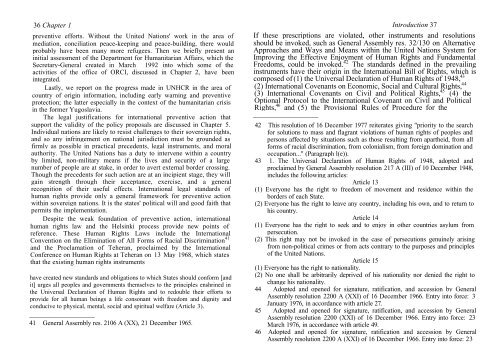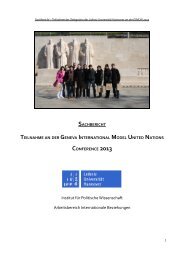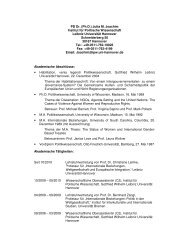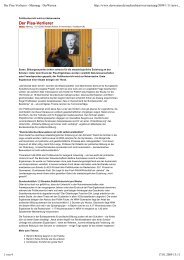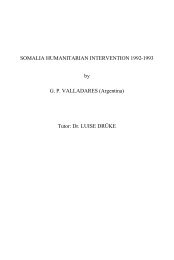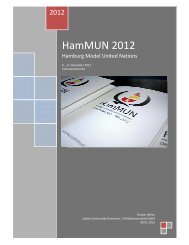Preventive Action for Refugee Producing Situations
Preventive Action for Refugee Producing Situations
Preventive Action for Refugee Producing Situations
Create successful ePaper yourself
Turn your PDF publications into a flip-book with our unique Google optimized e-Paper software.
36 Chapter 1<br />
preventive ef<strong>for</strong>ts. Without the United Nations' work in the area of<br />
mediation, conciliation peace-keeping and peace-building, there would<br />
probably have been many more refugees. Then we briefly present an<br />
initial assessment of the Department <strong>for</strong> Humanitarian Affairs, which the<br />
Secretary-General created in March 1992 into which some of the<br />
activities of the office of ORCI, discussed in Chapter 2, have been<br />
integrated.<br />
Lastly, we report on the progress made in UNHCR in the area of<br />
country of origin in<strong>for</strong>mation, including early warning and preventive<br />
protection; the latter especially in the context of the humanitarian crisis<br />
in the <strong>for</strong>mer Yugoslavia.<br />
The legal justifications <strong>for</strong> international preventive action that<br />
support the validity of the policy proposals are discussed in Chapter 5.<br />
Individual nations are likely to resist challenges to their sovereign rights,<br />
and so any infringement on national jurisdiction must be grounded as<br />
firmly as possible in practical precedents, legal instruments, and moral<br />
authority. The United Nations has a duty to intervene within a country<br />
by limited, non-military means if the lives and security of a large<br />
number of people are at stake, in order to avert external border crossing.<br />
Though the precedents <strong>for</strong> such action are at an incipient stage, they will<br />
gain strength through their acceptance, exercise, and a general<br />
recognition of their useful effects. International legal standards of<br />
human rights provide only a general framework <strong>for</strong> preventive action<br />
within sovereign nations. It is the states' political will and good faith that<br />
permits the implementation.<br />
Despite the weak foundation of preventive action, international<br />
human rights law and the Helsinki process provide new points of<br />
reference. These Human Rights Laws include the International<br />
Convention on the Elimination of All Forms of Racial Discrimination 41<br />
and the Proclamation of Teheran, proclaimed by the International<br />
Conference on Human Rights at Teheran on 13 May 1968, which states<br />
that the existing human rights instruments<br />
have created new standards and obligations to which States should con<strong>for</strong>m [and<br />
it] urges all peoples and governments themselves to the principles enshrined in<br />
the Universal Declaration of Human Rights and to redouble their ef<strong>for</strong>ts to<br />
provide <strong>for</strong> all human beings a life consonant with freedom and dignity and<br />
conducive to physical, mental, social and spiritual welfare (Article 3).<br />
___________________<br />
41 General Assembly res. 2106 A (XX), 21 December 1965.<br />
Introduction 37<br />
If these prescriptions are violated, other instruments and resolutions<br />
should be invoked, such as General Assembly res. 32/130 on Alternative<br />
Approaches and Ways and Means within the United Nations System <strong>for</strong><br />
Improving the Effective Enjoyment of Human Rights and Fundamental<br />
Freedoms, could be invoked. 42 The standards defined in the prevailing<br />
instruments have their origin in the International Bill of Rights, which is<br />
composed of (1) the Universal Declaration of Human Rights of 1948, 43<br />
(2) International Covenants on Economic, Social and Cultural Rights, 44<br />
(3) International Covenants on Civil and Political Rights, 45 (4) the<br />
Optional Protocol to the International Covenant on Civil and Political<br />
Rights, 46 and (5) the Provisional Rules of Procedure <strong>for</strong> the<br />
___________________<br />
42 This resolution of 16 December 1977 reiterates giving "priority to the search<br />
<strong>for</strong> solutions to mass and flagrant violations of human rights of peoples and<br />
persons affected by situations such as those resulting from apartheid, from all<br />
<strong>for</strong>ms of racial discrimination, from colonialism, from <strong>for</strong>eign domination and<br />
occupation..." (Paragraph l(e)).<br />
43 1. The Universal Declaration of Human Rights of 1948, adopted and<br />
proclaimed by General Assembly resolution 217 A (III) of 10 December 1948,<br />
includes the following articles:<br />
Article 13<br />
(1) Everyone has the right to freedom of movement and residence within the<br />
borders of each State.<br />
(2) Everyone has the right to leave any country, including his own, and to return to<br />
his country.<br />
Article 14<br />
(1) Everyone has the right to seek and to enjoy in other countries asylum from<br />
persecution.<br />
(2) This right may not be invoked in the case of persecutions genuinely arising<br />
from non-political crimes or from acts contrary to the purposes and principles<br />
of the United Nations.<br />
Article 15<br />
(1) Everyone has the right to nationality.<br />
(2) No one shall be arbitrarily deprived of his nationality nor denied the right to<br />
change his nationality.<br />
44 Adopted and opened <strong>for</strong> signature, ratification, and accession by General<br />
Assembly resolution 2200 A (XXI) of 16 December 1966. Entry into <strong>for</strong>ce: 3<br />
January 1976, in accordance with article 27.<br />
45 Adopted and opened <strong>for</strong> signature, ratification, and accession by General<br />
Assembly resolution 2200 (XXI) of 16 December 1966. Entry into <strong>for</strong>ce: 23<br />
March 1976, in accordance with article 49.<br />
46 Adopted and opened <strong>for</strong> signature, ratification and accession by General<br />
Assembly resolution 2200 A (XXI) of 16 December 1966. Entry into <strong>for</strong>ce: 23


